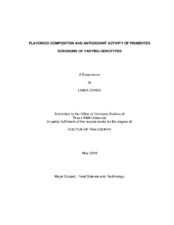| dc.description.abstract | A wide variety of sorghum genotypes with a pigmented pericarp were grown in varying environments and were analyzed for total phenols, condensed tannins, flavan-4-ols, and in vitro antioxidant activity. In addition, sorghum flavonoids were separated, characterized, and quantified using HPLC-PDA and LC-MS. Total phenols and in vitro antioxidant activity increased when sorghums had a pigmented testa causing the presence of condensed tannins. Flavan-4-ol levels were highest in sorghums with a black pericarp (5.8-16.1 abs/mL/g), followed by those with a red pericarp (1.1-9.2 abs/mL/g). Sorghums with a black pericarp had the highest 3-deoxyanthocyanin levels (308-1885 µg/g) and these were increased when the grain had minimal weathering and was darkest in color. Sorghums with a lemon-yellow pericarp had the highest flavanone levels (260-3586 µg/g) with eriodictyol being the main flavanone. Flavanone levels were increased when the grain was bright yellow with minimum weathering and were high compared to those found in common sources (238-574 µg/g, fresh wts.). No flavonoids were predominant in sorghums with a red pericarp. Flavonoid composition varied when all sorghums were grouped by secondary plant color. Sorghums with tan secondary plant color, including those with a white pericarp, had higher levels of flavones (50-932 µg/g) than those with red/purple secondary plant color (0-172 µg/g). On the other hand, 3-deoxyanthocyanin levels were higher in red/purple plant sorghums (14-1885 µg/g) than in tan plant sorghums (0-24 µg/g). Among red/purple plant sorghums, lemon-yellow pericarp sorghums had the highest levels of flavones (51-172 µg/g). Environment and weathering had an effect on flavonoid levels. The 3-deoxyanthocyanins were reduced for sorghums grown in a dry environment (i.e. Lubbock, TX) and flavonoid levels were increased in grains with minimum weathering or molding. This study reports that all sorghums, including those with a white pericarp, have flavonoids and their levels and compositions are affected by the genotype. This information will be helpful for plant breeders, food scientists, and the pharmaceutical/nutraceutical industries in selecting sorghums with desired healthy components. | en |


